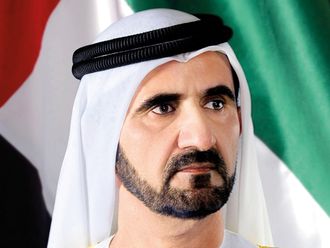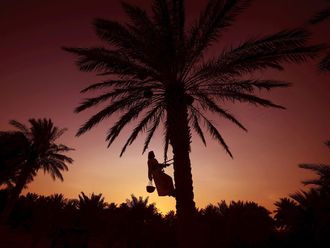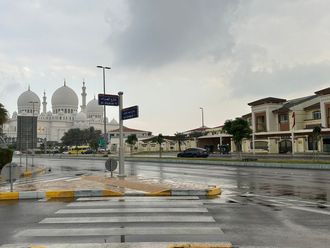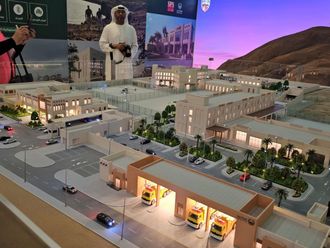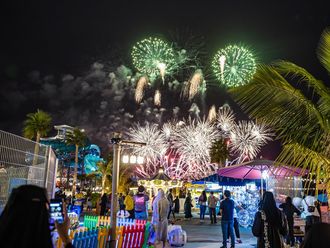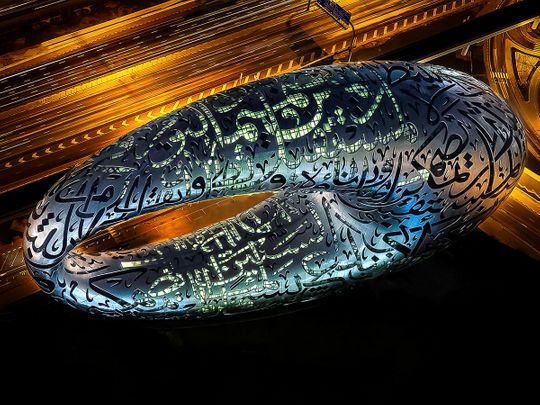
Dubai: Capacity to withstand 60°C, water proof and 50,000 hours of lifespan—the stunning calligraphy lighting on the façade of the newly-opened Museum of the Future in Dubai has many specialities. The details have been revealed to Gulf News by two key players behind the installation.
When His Highness Sheikh Mohammed bin Rashid Al Maktoum, Vice President and Prime Minister of the UAE and Ruler of Dubai, inaugurated the Museum of the Future on 22/02/22, “the most beautiful building on earth” was illuminated in its full glory. It was a moment of immense pride for everyone associated with the futuristic project, particularly the ones who worked behind the 14km-long façade lighting system of the building.
The spectacular lighting system assumed as much importance as the massive Arabic calligraphy designed by Emirati artist Mattar Bin Lahej that makes the oval-shaped building look unique from the outside.
Bill Johnson, managing director, and Baiju Chaliyil, managing partner, of lighting installation service provider Johnson Technical Services (JTS), said the concept of facade calligraphic lighting was designed and developed between the main design firm Killa Design and the engineering consultancy Buro Happold.

‘Packed with versatility’
“The lighting system installed on the facade is comprised of one fixture type but is packed with versatility,” said Johnson.
“The fixture itself is a rubberised, flexible linear LED light that is manufactured in 7m sections. This fitting is designed to withstand 60°C heat and is also completely water tight. The colour temperature is 3,000 Kelvin which is a mid-range white colour.”
He added: “These fixtures of OSRAM were supplied by Debbas. These are designed for a 50,000-hour life or roughly 17 years on the facade in Dubai’s weather conditions. We installed 14km of OSRAM diffused linear LED flex on the façade panels at the factory and all other relevant containment and cabling was done at site by JTS.”
‘Future’ lights up
The Arabic calligraphy designs are intricately 3D mapped onto the curved facade of the uniquely shaped building. The museum is comprised of pre-fabricated panels that are equipped with the lights in specially fabricated channels. Johnson said the panels were delivered to the site, lifted into their positions and bolted to the structure.
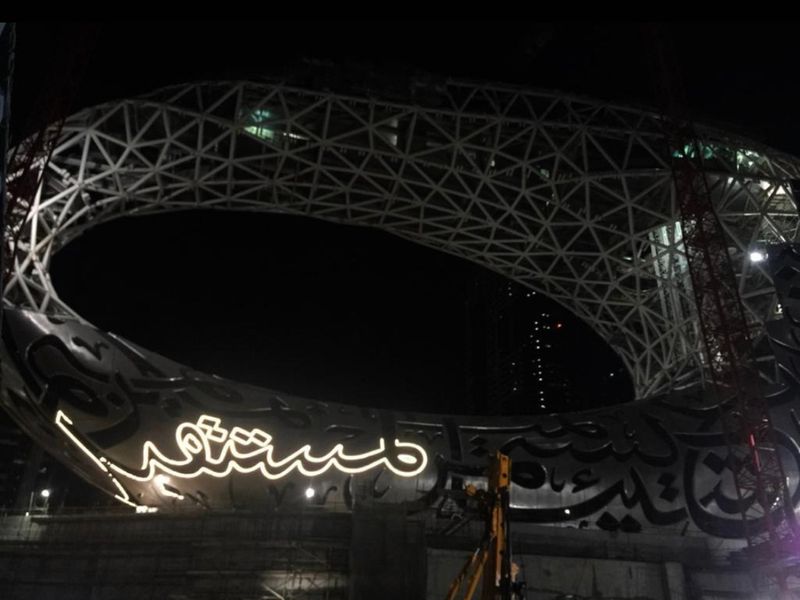
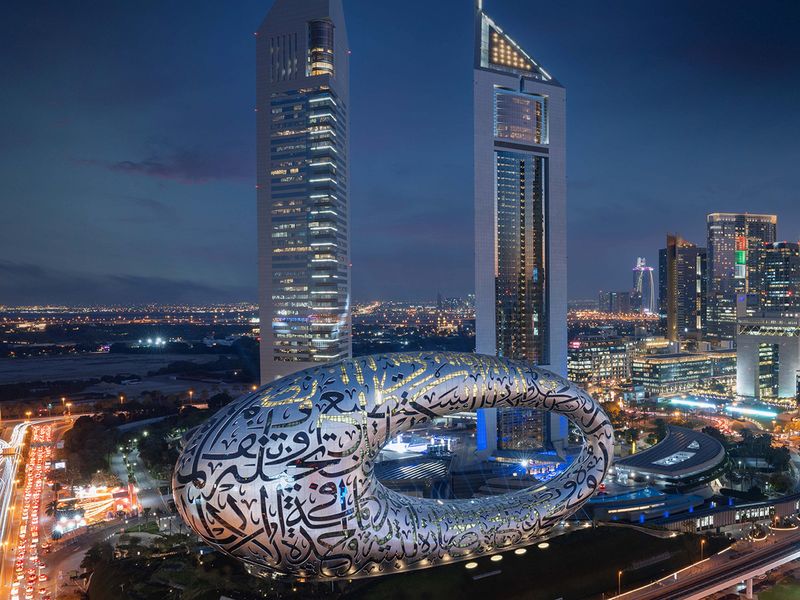
“At this point, JTS connected the feeds to conduits that feed the fixtures power and data. The data cables are connected to DMX Controllers that enable the linear lights to be dimmed or turned off. The panels are arranged around the Arabic calligraphy of Sheikh Mohammed’s poetry and connected in such a way that it allows for specific segments of the façade calligraphy to be turned on or off in sequence. “
This allows for segments of calligraphy to be turned on, telling a story or a specific message when the museum is viewed from a distance.
“The first word that was lit up for the first time on May 22, 2019 for His Highness was ‘Mustaqabal’ in Arabic, which means future in English,” he recalled.
Unique challenges
Chaliyil explained the challenges faced while the installing the unique lighting system. “As everyone knows, it’s a unique structure and designed with no pillar or column in the building. So, the installation of all the electrical containment was very challenging because of the shape of the structure,” he said.
“We got a limited space to run our containments and cables to coordinate with other services. The other challenge was to feed low voltage power to the equipment which was pre-installed into each bespoke panel at the factory and delivered to the site and assembled piece by piece like a jigsaw puzzle for which JTS would feed power from 2,600 low voltage transformers, each with its own DMX controller located in allocated spaces throughout the structure. Those transformers supply power to the diffused rubberized OSRAM linear LED lights.”
Many players, one goal
Chaliyil said 45 skilled technicians worked on the project for almost 35 months for the installation of the lighting. “We spend almost 54,000 man hours in the project. It was led by our senior project engineer Hazin Mohammed and supported by supervisor Sandeep Ajithkumar and foreman Vinod.”
also read
- The future is now: A look inside the Museum of the Future in Dubai
- 'The UAE is betting on the future,' says Mohammed bin Rashid after visiting Museum of the Future in Dubai
- What is written in Arabic on the exterior of Dubai’s Museum of the Future?
- Look: Dubai's landmark Museum of the Future opens with a message of hope
He added that the project was a perfect example of team work among Bam International, Debbas Lighting, OSRAM, Traxon ECue and JTS. “Everyone’s contribution was equally important to meet the design concept of the calligraphy lighting and all the teams completed their scope brilliantly. That is why the building and the calligraphy lighting look stunning now.”
Chaliyil said all team members are proud that the building has become a global architectural icon.
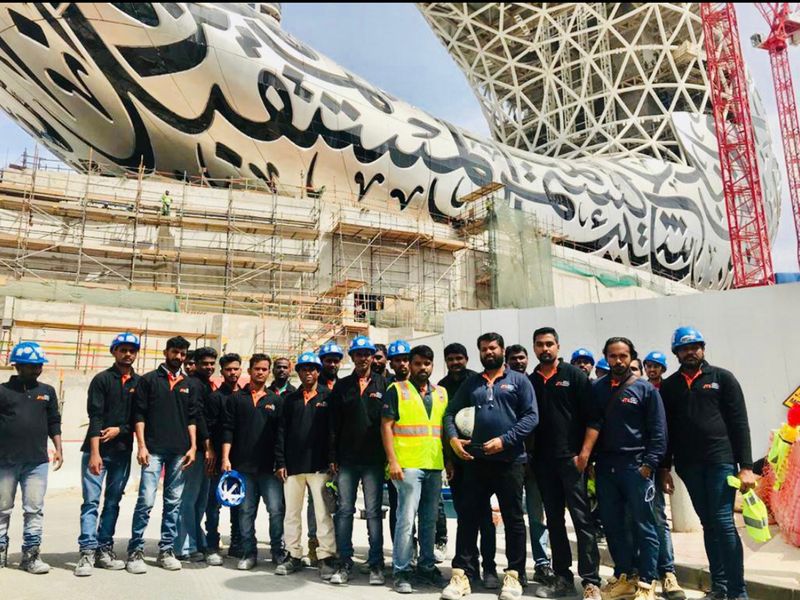
“The role of lighting in the building façade was to highlight the calligraphy art and we amazingly achieved that task. It was a very proud moment for all of us to see the building lit up during the inaugural ceremony. We are part of the history now because we worked on the ‘Most Beautiful Building on Earth’,” he added.
Chaliyil said JTS had also contributed in the installation of facade lighting in many signature projects in the UAE such as the Burj Khalifa Media Screen, Al Wasal Plaza Expo 2020 Dubai, Abu Dhabi Global Market media facade, and Mubadala-IPIC Tower media facade, among others.


